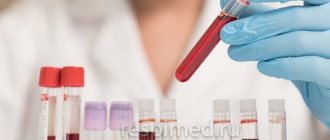Scientific editor: M. Merkusheva, PSPbSMU named after. acad. Pavlova, medical practice. November, 2021.
Synonyms: Alkaline phosphatase, alkaline phosphatase, ALP.
The degree of alkaline phosphatase activity is determined by a biochemical blood test. This indicator is considered the most important diagnostic criterion for diseases of the musculoskeletal system, liver, kidneys and other internal organs.
Alkaline phosphatase is the general name for a group of enzymes that take an active part in calcium-phosphorus metabolism, namely, in the process of breaking down phosphoric acid. Phosphatases are localized in the membranes of almost all cells of the body, but most of them are located in the tissues of the liver, bile duct, intestines, kidneys, bones, and placenta.
Basic information
The group of phosphatases in the human body is represented by 11 isoenzymes, of which the most basic are:
- ALPI – intestinal phosphatase;
- ALPL – nonspecific (from liver, bone, kidney tissues) phosphatase;
- ALPP – placental phosphatase.
Normally, alkaline phosphatase consists of 2 fractions: bone and liver isoenzymes (bone - in osteoblasts, liver is secreted in bile), the quantitative content of which in blood serum is approximately the same. But in some cases, this ratio may change or be “diluted” by the inclusion of other types of isoenzymes. Such situations include pathological conditions, for example, damage to cells of a mechanical, inflammatory nature, or any physiological characteristics of the body.
The following diseases can provoke an increase in alkaline phosphatase activity:
- organs of the hepatobiliary system;
- musculoskeletal system;
- digestive tract organs;
- malignant neoplasms;
- endocrine disorders.
In addition, an increase in phosphatase values can be observed in completely healthy people with an intense (stronger than usual) metabolism, in pregnant women and in children during the period of active bone growth.
A decrease in alkaline phosphatase activity is recorded extremely rarely and most often this occurs against the background of insufficiency of the thyroid gland, malnutrition (fasting, strict diets), deficiency of vitamins and microelements, etc.
General information
ALP is present in many tissues. An increase in its concentration in the blood occurs with significant damage to a particular tissue. The presence of a small amount of enzyme in the bloodstream is explained by the process of cell renewal and does not indicate the presence of a disease. A significant increase in indicators is characteristic of cholestasis (stagnation of bile, which is caused by an obstacle to its outflow, for example, stones). Large amounts of the enzyme are often found in bone tissue. It is present in cells that are involved in bone turnover and growth. Therefore, ALP is significantly increased in patients with fractures and in children.
Indications for the study
The results are prescribed and interpreted by specialists: therapist, gastroenterologist, hepatologist, infectious disease specialist, hematologist, endocrinologist, surgeon, general practitioner, pediatrician.
- Obstructive diseases of the liver and biliary tract;
- Inflammatory diseases of the biliary tract;
- Pathologies of the skeletal system, incl. primary and metastatic cancer;
- Oncological diseases of the kidneys;
- Infectious mononucleosis (an acute viral disease that causes liver damage).
- Individual monitoring of patients with osteoporosis receiving antiresorptive agents.
An alkaline phosphatase test is mandatory in the program of routine medical examinations and when preparing a patient for surgery. Also, a phosphatase test is included in the list of “liver tests” when a diagnostic test of liver function is prescribed.
In addition, it is recommended to evaluate alkaline phosphatase activity if the patient complains of:
- increased fatigue;
- weakness;
- disturbance or lack of appetite;
- nausea/vomiting;
- pain in the abdomen/right hypochondrium;
- yellowness of the skin;
- change in the color of urine and/or feces;
- skin itching;
- feeling of aching bones;
- frequent fractures and/or bone deformities.
Repeated alkaline phosphatase testing is usually ordered to monitor the course of the disease and/or evaluate the effectiveness of treatment.
Reference values
Important! Standards may vary depending on the reagents and equipment used in each particular laboratory. That is why, when interpreting the results, it is necessary to use the standards adopted in the laboratory where the analysis was carried out. You also need to pay attention to the units of measurement.
Alkaline phosphatase standards according to the independent laboratory Invitro:
| Floor | Age | Norms (U/l) |
| Both boys and girls | up to 15 days | 90-273 |
| 15 days - 1 year | 134-518 | |
| 1 year - 10 years | 156-369 | |
| 10 years - 13 years | 141-460 | |
| Women | 13 years - 15 years | 62-280 |
| over 15 years old | 40-150 | |
| Men | 13 years – 15 years | 127-517 |
| 15 years - 17 years | 89-365 | |
| 17 years -19 years | 59-164 | |
| over 19 years old | 40-150 |
Helix laboratory standards:
| Age, gender | Reference values | |
| up to 15 days | 83 - 248 U/l | |
| 15 days - 1 year | 122 - 469 U/l | |
| 1-10 years | 142 - 335 U/l | |
| 10-13 years | 129 – 417 U/l | |
| 13-15 years old | female | 57 - 254 U/l |
| male | 116 - 468 U/l | |
| 15-17 years old | female | 50 - 117 U/l |
| male | 82 - 331 U/l | |
| 17-19 years old | female | 45 - 87 U/l |
| male | 55 - 149 U/l | |
| over 19 years old | female | 35 - 105 U/l |
| male | 40 – 130 U/l | |
Laboratory Diagnostic Manual Alkaline Phosphatase Data:
| Age | Total, IU/l | Bone,% |
| Newborns | 35 — 106 | |
| 1 month | 71 — 213 | 85 |
| 3 years | 71 — 142 | 85 |
| 10 years | 106 — 213 | 85 |
| Adults under 31 years old | 39 — 92 | 60 |
| Adults over 31 years of age | 39 — 117 | 40 |
Interpretation of results
Reference values for the concentration of this enzyme are 240-270 U/l. An increase in indicators during pregnancy usually does not indicate pathology and is explained by physiological processes in the woman’s body. Enzyme deficiency is rare. Its excess can indicate a number of diseases (rickets, mononucleosis, some types of oncology, bacterial infection, etc.). The diagnosis is established taking into account the clinical picture, the results of other laboratory and instrumental studies. Sometimes the amount of enzyme increases in healthy people. Only a doctor can correctly interpret the test results; it is unacceptable to use it for self-diagnosis.
Factors of influence
Increase the values:
- last trimester of pregnancy (alkaline phosphatase is contained in the placenta);
- postmenopause (the period after menopause);
- condition after bone fractures (healing stage);
- prematurity (in newborns);
- childhood/adolescence (active bone growth);
- violation of the rules for transportation and storage of biomaterial (cooling of blood after collection);
- taking medications with high hepatotoxicity (aggressive effect on the liver):
- methotrexate;
- chlorpromazine;
- paracetamol;
- aspirin;
- allopurinol;
- broad-spectrum antibiotics;
- sulfonamides;
- taking large doses of ascorbic acid (vitamin C), magnesium;
- deficiency of phosphates and calcium in the diet.
Lower the values
- malnutrition (lack of magnesium and zinc in food);
- taking medications:
- oral contraceptives;
- estrogens;
- clofibrate;
- danazol;
- azathioprine;
- the presence of impurities in laboratory glassware: arsenic, citrate, beryllium, EDTA, etc. (laboratory technician’s mistake when choosing a container).
Important! The interpretation of the results is always carried out comprehensively. It is impossible to make an accurate diagnosis based on only one analysis.
Increasing values
Diseases of the liver and biliary tract:
- obstruction of the bile ducts and, as a consequence, obstructive jaundice:
- gallstones,
- tumor formations of the bile ducts;
- cancer of the head of the pancreas, stomach (provokes mechanical compression of the common bile duct);
- primary and/or secondary (metastatic) liver cancer;
- liver cirrhosis (pathological process of replacement of healthy organ tissue with connective (scar) tissue, as a result of which liver function is inhibited);
- hepatitis of any etiology (alkaline phosphatase activity in this case is 3 times higher than normal values);
- infectious mononucleosis (an acute viral pathology during which liver function is affected);
- autoimmune lesions of the biliary tract (rare hereditary diseases: primary biliary cirrhosis and primary sclerosing cholangitis). In this case, there is also a simultaneous increase in the values of alkaline phosphatase and gamma-GTP to high levels;
Pathology of bone tissue:
- Paget's disease (abnormal bone growth and local disruption of their structure);
- osteomalacia (pathological softening of bone tissue caused by calcium deficiency);
- rickets (impaired bone formation and insufficient bone mineralization, manifests itself in infants and young children);
- osteosarcoma (primary bone cancer) and metastases from cancer foci in other organs;
Other reasons:
- myocardial, lung, kidney infarction;
- ulcerative colitis, intestinal perforation;
- cytomegaly in children (viral disease, the liver and spleen are involved in the pathological process);
- hyperparathyroidism (intensive leaching of calcium from bone tissue against the background of hyperfunction of the parathyroid glands).
Nonspecific alkaline phosphatase is present on the membrane of neurons and may play a role in neurodegeneration in Alzheimer's disease; almost all patients with Alzheimer's disease have an increase in alkaline phosphatase in the blood.
Note: if, along with high alkaline phosphatase activity, other biochemical blood parameters (bilirubin, ALT, AST) are also elevated, then liver damage is likely. If the level of calcium and phosphorus increases, bone pathology is suspected. A simultaneous increase in alkaline phosphatase and gamma GTP is a sign of biliary tract diseases.
Alkaline phosphatase
Alkaline phosphatase is a group of enzymes found in almost all tissues of the body, with a predominant localization in the liver, bones and placenta.
Research method
Kinetic colorimetric method.
Units
U/L (unit per liter).
What biomaterial can be used for research?
Venous, capillary blood.
How to properly prepare for research?
- Do not eat for 12 hours before the test.
- Avoid physical and emotional stress 30 minutes before the test.
- Do not smoke for 30 minutes before donating blood.
General information about the study
Alkaline phosphatase is an enzyme that is found in the cells of the liver and biliary tract and is a catalyst for certain biochemical reactions in these cells (it does not work in the bloodstream). When these cells are destroyed, their contents enter the bloodstream. Normally, some cells are renewed, so a certain alkaline phosphatase activity is detected in the blood. If many cells die, it can increase very significantly.
Alkaline phosphatase activity increases greatly when there is an obstruction to the flow of bile, such as stones in the bile ducts.
In bones, alkaline phosphatase is formed in special cells - osteoblasts, which play an important role in the formation and renewal of bone tissue. The higher the activity of osteoblasts, the higher the activity of alkaline phosphatase in the blood, so in children and people who have suffered bone fractures, alkaline phosphatase activity is at a high level.
Alkaline phosphatase is also found in intestinal and placental cells.
What is the research used for?
This test is usually prescribed to detect liver or bone diseases. In addition, alkaline phosphatase is elevated in diseases affecting the bile ducts, so this test helps confirm blockage of the bile duct due to stones in the bile ducts or pancreatic tumors.
An alkaline phosphatase test, as well as a gamma-glutamyl transferase test, is carried out in order to diagnose diseases affecting the biliary tract: primary biliary cirrhosis and primary sclerosing cholangitis.
Any condition that involves bone growth or increased bone cell activity increases alkaline phosphatase activity. Repeated administration of alkaline phosphatase is used to monitor the activity of diseases in which it is elevated or to evaluate the effectiveness of treatment.
What do the results mean?
| Age, gender | Reference values |
| 17-19 years old, female | 45 - 87 U/l |
| 17-19 years old, male | 55 - 149 U/l |
| > 19 years old, female | 35 - 105 U/l |
| > 19 years old, male | 40 – 130 U/l |
If the values obtained as a result of other tests, such as bilirubin test, ALT, AST, are also elevated, then the increase in alkaline phosphatase activity in the blood may be due to liver damage.
If calcium and phosphorus levels are altered, the most likely cause of elevated alkaline phosphatase is bone pathology.
An increase in alkaline phosphatase activity almost always means damage or involvement in the pathological process of the liver, biliary tract or bones.
Reasons for increased alkaline phosphatase activity
1. Damage to the liver and bile ducts.
2. Bone damage.
3. Other reasons.
- Hyperparathyroidism.
- Myocardial infarction.
- Ulcerative colitis, intestinal perforation.
Reasons for decreased alkaline phosphatase activity
- Severe anemia.
- Massive blood transfusions.
- Hypothyroidism.
- Lack of magnesium and zinc.
- Hypophosphatasia.
- A pronounced decrease in alkaline phosphatase in pregnant women is a sign of placental insufficiency.
What can influence the result?
- During pregnancy, alkaline phosphatase activity is normally increased, as it is contained in the placenta.
- A temporary increase in alkaline phosphatase activity is observed after fractures.
- In children and young people, alkaline phosphatase activity is higher than in adults, which is how their bones grow.
- Aspirin, paracetamol, allopurinol, antibiotics and a number of other drugs can increase the activity of alkaline phosphatase.
- Taking oral contraceptives sometimes leads to a decrease in alkaline phosphatase activity.
Important Notes
Alkaline phosphatase activity sometimes increases in healthy individuals; this does not necessarily indicate any pathology. To correctly interpret changes in alkaline phosphatase activity, a comprehensive assessment of the results of other tests, as well as other medical data, is needed.
Lowering values
- Anemia (low blood hemoglobin, severe course);
- Scurvy (acute deficiency of vitamin C, manifested by loosening and bleeding gums);
- Vitamin B12 deficiency;
- Hemotransfusion (blood transfusion);
- Kwashiorkor (severe dystrophy caused by protein deficiency, most often develops in children 1-4 years old);
- Hypothyroidism (underfunction of the thyroid gland);
- Achondroplasia (hereditary disorder of the growth processes of long bones, dwarfism);
- Hypophosphatasia (a rare congenital disease that causes softening of bone tissue);
- Cretinism (abnormal development of the thyroid gland, dementia);
- Pregnant women have placental insufficiency.
Sources:
- Sonia A Talwar, MD. Bone Markers in Osteoporosis. — Medscape, Jan 2021
- Data from the independent laboratory Invitro.
- Data from Helix laboratory.
- A.A. Kishkun, Doctor of Medical Sciences, Prof. Guide to laboratory diagnostic methods, - GEOTAR-Media, 2007.
- Vardy ER. Alkaline phosphatase is increased in both brain and plasma in Alzheimer's disease. — Neuro-degenerative diseases 2012;9(1):31-7






